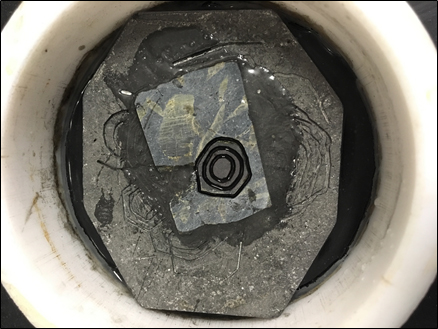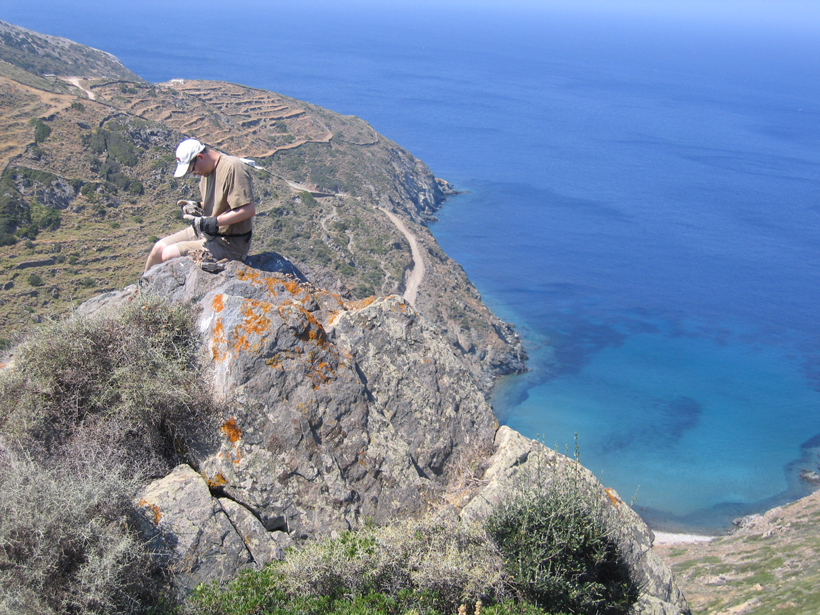Researchers have long pondered why arc magmas are more oxidized than other volcanic rocks, explained Ethan Baxter, a geochemist at Boston College. Baxter and his colleagues recently “fingerprinted” the source of oxidizing fluids in subduction zones, bringing researchers closer to answering this question.
The research “was exciting because it was conducted by a master’s student [Anna Gerrits, whose research interests sparked the investigation], and it brought together a large, collaborative [international] group” of researchers from different specialties, Baxter said.
“Metamorphic rocks can be incredibly complex, so when a study reaches in and draws out a simple result, it can be incredibly revealing.”
For three zoned garnet crystals from Sifnos, Greece, researchers measured the oxygen fugacity (which they describe as a thermodynamic property serving as a chemical control in subduction zones and other environments) and stable iron isotope composition. It’s the first study to examine “zonation of iron isotopes from garnet crystals in a subduction zone,” Baxter said.
The study concludes that the garnets and the surrounding mineral assemblage display “a record of progressive dehydration,” including lawsonite dehydration. Garnet interiors grew under relatively oxidized conditions, the researchers said, whereas the rims record reduced conditions. These findings support an existing hypothesis that sulfate or other oxidizing species released during dehydration of subducting lithologies contribute to oxidation of the mantle wedge above subduction zones.
“It’s a careful study, with a tantalizing result,” Katherine Kelley, a professor of oceanography at the University of Rhode Island, wrote in an email to Eos. “Metamorphic rocks can be incredibly complex, so when a study reaches in and draws out a simple result, it can be incredibly revealing.”
Greek Crystals
The garnet crystals came from a suite of subduction zone samples that were previously collected from Sifnos, Baxter said. About 45 million years ago, the area was rich with volcanic explosions triggered by geological activity.

Although the three crystals under study share a similar subduction history, their compositions and redox records are varied, Baxter noted. Two of the rocks show systemic changes in iron isotope compositions, indicating that they were still growing while lawsonite breakdown occurred. However, those changes aren’t present in the third rock, demonstrating that it stopped growing before any major release of water occurred. The absence of these changes in the third sample clued the team into the conditions responsible for the release of oxidizing fluids in subduction zones.
“The method these authors used, to extract the individual growth zones of a single crystal and perform isotopic analysis on [it], is a novel approach that will ultimately tell us even more about the conditions [occurring] during metamorphism of these types of rocks at depth.…This opens up many new doors to discovery of the metamorphic processes in the subducting plate,” Kelley said.
Because the results of this study are based on the study of three rocks collected from one island, Baxter said the team wants to analyze rocks collected from other field sites, such as the Italian Alps, to look for global trends applying to subduction zones. The team also wants to delve into why fluids released in subduction zones are oxidized and “the chemistry responsible for creating that oxidizing fluid,” he said.
The researchers reported their results in a 28 October Nature Geoscience paper.
—Rachel Crowell (@writesRCrowell), Science Writer
Citation:
Crowell, R. (2019), Using garnets to explore arc magma oxidation, Eos, 100, https://doi.org/10.1029/2019EO136924. Published on 26 November 2019.
Text © 2019. The authors. CC BY-NC-ND 3.0
Except where otherwise noted, images are subject to copyright. Any reuse without express permission from the copyright owner is prohibited.

